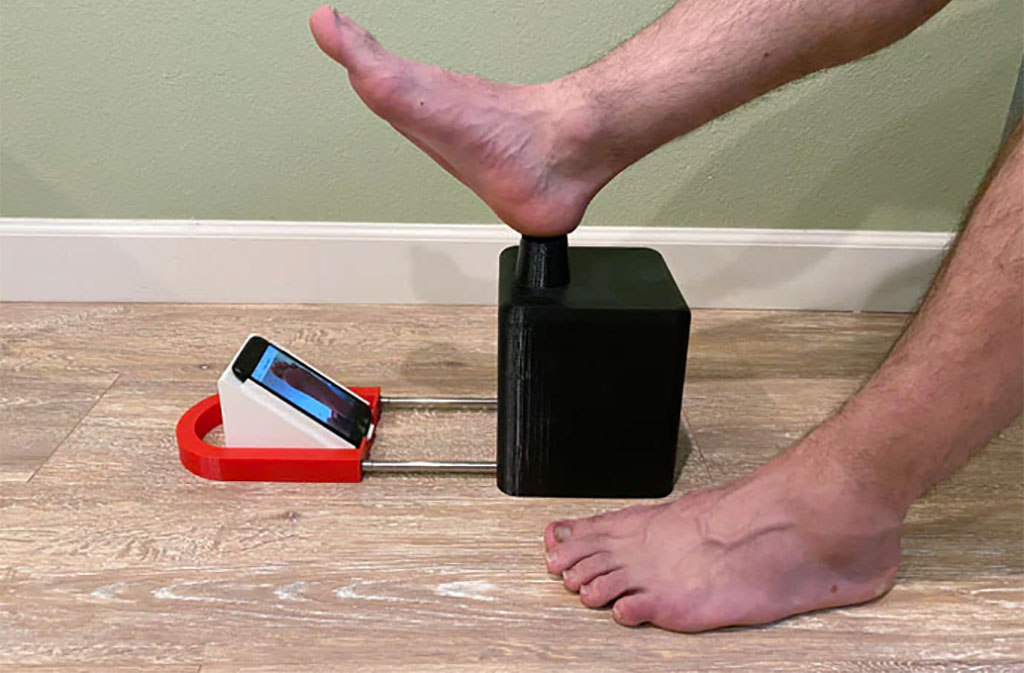Selfies' May Improve Remote Diabetic Foot Monitoring
|
By HospiMedica International staff writers Posted on 23 Nov 2021 |

Image: The Foot Selfie System (Photo courtesy of Mark Swerdlow/ USC)
A simple 3D-printed device allows patients to take standardized photos of the entire plantar surface of their feet with a phone app, using voice commands.
Developed at the University of Southern California (USC; Los Angeles, USA), the “Foot Selfie” device is a smartphone-based positioning device that enables patients to monitor diabetic foot ulcers (DFUs) without assistance and transmit the images to a remote server. The 3D system consists of a heel platform, a smartphone holder, and a base that connects the two via telescoping rods. The Foot Selfie smartphone app, for both iOS and Android, directs users to take voice-activated photos, view them, and upload them for review by healthcare providers, flagging concerns.
In a pilot study, 15 patients from a limb-salvage clinic were asked to image the plantar surface of their feet daily for six months and to evaluate the system by questionnaire at five time points. The results showed that the participants uploaded images on a median of 76% of eligible study days. In all, 12 active wounds and 39 pre-ulcerative lesions were monitored. Healing of seven wounds and reversal of 20 pre-ulcerative lesions were observed during the study period. The study was published on October 31, 2021, in Journal of Diabetes Science and Technology.
“Participants rated the system as useful, empowering, and preferable to their previous methods of foot screening. With minimal training, patients transmitted diagnostic-quality images from home on most days, allowing clinicians to review serial images,” said lead author and device developer Mark Swerdlow, MSc. “Further studies are needed to determine whether it can reduce morbidity of DFUs and/or the associated cost of care. Artificial intelligence integration could improve scalability.”
Diabetes patients often suffer from nerve and circulation problems in the feet, which reduce their perception of pain. The nerve pathways that ensure that weight is automatically transferred from one foot to the other during prolonged standing are disrupted, and as a result, diabetics do not notice that their toes, heels, or the balls of their feet are too heavily loaded. The foot receives no relief, and pressure sores, DFUs, and infections may go unnoticed. Serious cases may even lead to amputation.
Related Links:
University of Southern California
Developed at the University of Southern California (USC; Los Angeles, USA), the “Foot Selfie” device is a smartphone-based positioning device that enables patients to monitor diabetic foot ulcers (DFUs) without assistance and transmit the images to a remote server. The 3D system consists of a heel platform, a smartphone holder, and a base that connects the two via telescoping rods. The Foot Selfie smartphone app, for both iOS and Android, directs users to take voice-activated photos, view them, and upload them for review by healthcare providers, flagging concerns.
In a pilot study, 15 patients from a limb-salvage clinic were asked to image the plantar surface of their feet daily for six months and to evaluate the system by questionnaire at five time points. The results showed that the participants uploaded images on a median of 76% of eligible study days. In all, 12 active wounds and 39 pre-ulcerative lesions were monitored. Healing of seven wounds and reversal of 20 pre-ulcerative lesions were observed during the study period. The study was published on October 31, 2021, in Journal of Diabetes Science and Technology.
“Participants rated the system as useful, empowering, and preferable to their previous methods of foot screening. With minimal training, patients transmitted diagnostic-quality images from home on most days, allowing clinicians to review serial images,” said lead author and device developer Mark Swerdlow, MSc. “Further studies are needed to determine whether it can reduce morbidity of DFUs and/or the associated cost of care. Artificial intelligence integration could improve scalability.”
Diabetes patients often suffer from nerve and circulation problems in the feet, which reduce their perception of pain. The nerve pathways that ensure that weight is automatically transferred from one foot to the other during prolonged standing are disrupted, and as a result, diabetics do not notice that their toes, heels, or the balls of their feet are too heavily loaded. The foot receives no relief, and pressure sores, DFUs, and infections may go unnoticed. Serious cases may even lead to amputation.
Related Links:
University of Southern California
Latest Patient Care News
- Revolutionary Automatic IV-Line Flushing Device to Enhance Infusion Care
- VR Training Tool Combats Contamination of Portable Medical Equipment
- Portable Biosensor Platform to Reduce Hospital-Acquired Infections
- First-Of-Its-Kind Portable Germicidal Light Technology Disinfects High-Touch Clinical Surfaces in Seconds
- Surgical Capacity Optimization Solution Helps Hospitals Boost OR Utilization

- Game-Changing Innovation in Surgical Instrument Sterilization Significantly Improves OR Throughput
- Next Gen ICU Bed to Help Address Complex Critical Care Needs
- Groundbreaking AI-Powered UV-C Disinfection Technology Redefines Infection Control Landscape
- Clean Hospitals Can Reduce Antibiotic Resistance, Save Lives
- Smart Hospital Beds Improve Accuracy of Medical Diagnosis
- New Fast Endoscope Drying System Improves Productivity and Traceability
- World’s First Automated Endoscope Cleaner Fights Antimicrobial Resistance
- Portable High-Capacity Digital Stretcher Scales Provide Precision Weighing for Patients in ER
- Portable Clinical Scale with Remote Indicator Allows for Flexible Patient Weighing Use
- Innovative and Highly Customizable Medical Carts Offer Unlimited Configuration Possibilities
- Biomolecular Wound Healing Film Adheres to Sensitive Tissue and Releases Active Ingredients
Channels
Critical Care
view channel
CPR Guidelines Updated for Pediatric and Neonatal Emergency Care and Resuscitation
Cardiac arrest in infants and children remains a leading cause of pediatric emergencies, with more than 7,000 out-of-hospital and 20,000 in-hospital cardiac arrests occurring annually in the United States.... Read more
Ingestible Capsule Monitors Intestinal Inflammation
Acute mesenteric ischemia—a life-threatening condition caused by blocked blood flow to the intestines—remains difficult to diagnose early because its symptoms often mimic common digestive problems.... Read more
Wireless Implantable Sensor Enables Continuous Endoleak Monitoring
Endovascular aneurysm repair (EVAR) is a life-saving, minimally invasive treatment for abdominal aortic aneurysms—balloon-like bulges in the aorta that can rupture with fatal consequences.... Read more
Wearable Patch for Early Skin Cancer Detection to Reduce Unnecessary Biopsies
Skin cancer remains one of the most dangerous and common cancers worldwide, with early detection crucial for improving survival rates. Traditional diagnostic methods—visual inspections, imaging, and biopsies—can... Read moreSurgical Techniques
view channel
Robotic Assistant Delivers Ultra-Precision Injections with Rapid Setup Times
Age-related macular degeneration (AMD) is a leading cause of blindness worldwide, affecting nearly 200 million people, a figure expected to rise to 280 million by 2040. Current treatment involves doctors... Read more
Minimally Invasive Endoscopic Surgery Improves Severe Stroke Outcomes
Intracerebral hemorrhage, a type of stroke caused by bleeding deep within the brain, remains one of the most challenging neurological emergencies to treat. Accounting for about 15% of all strokes, it carries... Read moreHealth IT
view channel
Printable Molecule-Selective Nanoparticles Enable Mass Production of Wearable Biosensors
The future of medicine is likely to focus on the personalization of healthcare—understanding exactly what an individual requires and delivering the appropriate combination of nutrients, metabolites, and... Read moreBusiness
view channel
Philips and Masimo Partner to Advance Patient Monitoring Measurement Technologies
Royal Philips (Amsterdam, Netherlands) and Masimo (Irvine, California, USA) have renewed their multi-year strategic collaboration, combining Philips’ expertise in patient monitoring with Masimo’s noninvasive... Read more
B. Braun Acquires Digital Microsurgery Company True Digital Surgery
The high-end microsurgery market in neurosurgery, spine, and ENT is undergoing a significant transformation. Traditional analog microscopes are giving way to digital exoscopes, which provide improved visualization,... Read more
CMEF 2025 to Promote Holistic and High-Quality Development of Medical and Health Industry
The 92nd China International Medical Equipment Fair (CMEF 2025) Autumn Exhibition is scheduled to be held from September 26 to 29 at the China Import and Export Fair Complex (Canton Fair Complex) in Guangzhou.... Read more














